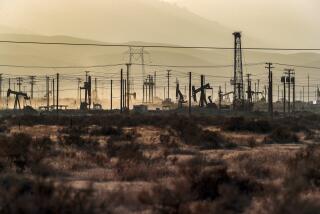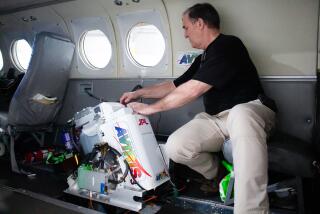Scientists Exploring Novel Ways to Get Carbon Dioxide Under Control
- Share via
MORGANTOWN, W.Va. — Researchers at the National Energy Technology Laboratory use big words to explain their work, words like “terrestrial carbon sequestration” and “gigaton.”
Perhaps that’s because of the scope of their task: Cleaning up the Earth’s air is a big job.
Scientists here are studying ways to suck carbon dioxide out of the atmosphere and lock it up so it can no longer contribute to global warming.
Their ideas? Permanently store the so-called greenhouse gas inside certain minerals or in depleted oil and gas fields. Use it to replenish poor soils and grow trees. Inject it into geologic formations under the ocean.
Carbon dioxide, generated by cars, power plants and other industries, is the single largest component of the gases that are believed to be slowly warming the planet. Too much warmth means melting glaciers, rising sea levels and other ecological problems.
The industries that produce carbon dioxide are not required to capture and sequester it yet, but regulations appear likely in the long run, says Carl Bauer, associate director of the lab’s Office of Coal and Environmental Systems.
The lab is one of 15 national labs operated by the Department of Energy.
“Utilities are not going to be doing any of this until it’s clearly defined and there is a requirement,” he says. “We need to develop technology for when they get there.”
And it has to be done affordably so developing countries can follow suit.
“Research has got to find viable, cost-effective solutions. When people are in survival or subsistence mode, they can’t afford to think about the niceties,” Bauer says. “Environmental and economic improvement going hand in hand is what we really want to see, and we want to be part of the solution for the whole world.”
Researchers are trying to create ultra-thin membranes that capture CO2but let other gases pass. That could lead to the development of filters for power plants. They’re trying to develop low-temperature solvents for air-scrubbing devices on smokestacks so they can turn carbon dioxide into a hydrate, an ice-like structure that contains water.
And they’re studying the idea of storing the gas in the deep ocean. “But it’s the most environmentally sensitive place on the earth, so we need to understand it better,” says project manager Chuck Schmidt.
Other techniques are simpler.
Thomas Feeley is in charge of a project to use CO2 to make things grow on old strip mines, overworked farms and other degraded lands.
“From early on, we’re taught plants and trees take carbon dioxide out of the atmosphere, then turn green and grow,” Feeley says. “This is a project where people can actually see it working.”
Across the country there are about 71.5 million acres of marginal farmland and 1.6 million acres of abandoned strip mines. Feeley’s teams will use coal-combustion products like fly ash to rehabilitate soils.
“Most of the organic material has already been stripped away, so this replaces that and allows a foothold for vegetation to grow,” Feeley says.
At a Tennessee Valley Authority power plant in Paradise, Ky., researchers will add fly ash to 250 acres of soil and replant to see if the theory works.
And in a lab at Stephen F. Austin State University in Nacogdoches, Texas, scientists will study trees to determine how much carbon is inside.
“We know that’s what trees do, but we don’t know exactly how much is stored,” Feeley said. “We think one to 10 tons of carbon could be stored on 2.5 acres, but that’s just an estimate.”
Precise numbers could help urban planners decide how much green space to require for large construction projects. It could also help create a credit-trading program for industry.
“Even if you’re not a believer that there is a climate-change issue, the idea of taking these lands that are unproductive, that have no value, and making them into productive ecosystems is a win-win situation,” Feeley says.
Another technique for storing CO2, still in the experimental stage, is to form carbonates using such minerals as olivine and serpentine to permanently absorb the gas. A chemical change occurs when carbon dioxide is exposed to the mineral and a mild acid, then subjected to pressure for 30 minutes.
With olivine, the green rock that gives Hawaii its unique Big Island beaches, the rock turns white. Even if the rock is ground to a powder, the carbon dioxide remains permanently stored. It cannot be released into the atmosphere.
“So far, this has only been done in the lab, but it can be done,” Bauer says. The work continues not only in West Virginia but at the Albany Research Center in New York and at Los Alamos National Laboratory in New Mexico.
“This phenomenon occurs in nature, but it takes hundreds of years to happen,” Bauer says. “Here, 30 minutes later, the rock is changed.”
Next spring, the West Virginia scientists will team up with Los Alamos and Sandia National Laboratories in Albuquerque on an experiment that will fill the recesses of a depleted New Mexico oil field with gas.
“Nature has stored hydrocarbons in there for eons, so we think we should be able to put carbon dioxide in there and have it stay there for eons,” says Schmidt.
New Mexico Tech and Strata Oil Production Co. are also participating in the test, during which scientists will inject up to 10,000 tons of CO2 into the West Pearl Queen oil field near Roswell.
For three years, the field will be monitored to see how efficiently the gas is stored. Then the team will pump the gas back out and see if it has changed.
Key questions for the researchers: Will the additional pressure change the integrity of the geologic formation? Will the gas form carbonates, locking up with the minerals underground?
“This is the first time anyone has put carbon dioxide into an oil field just to store it and see what happens,” Schmidt says.
Some companies use carbon dioxide to repressurize their depleted fields and try to squeeze out more oil, but they pump it back out right away. That’s because they paid for the gas, which is hard to capture.
The researchers are also buying CO2 for their experiment, but they could eventually capture it from a Four Corners power plant.
If the experiment goes well, Schmidt says, the nation’s tapped-out oil and gas reservoirs could become giant storage tanks for 100 billion tons of CO2. That’s nearly all the carbon dioxide that will be produced in the burning of fossil fuels for the next 18 years.
And the experiment could be repeated in former coal mines, where methane gas could be captured and sold while the CO2 remains underground.
“About 90% of the nation’s coal is unminable,” Schmidt says, “so there is a lot of potential.”
National Energy Technology Laboratory: https://www.netl.doe.gov/






